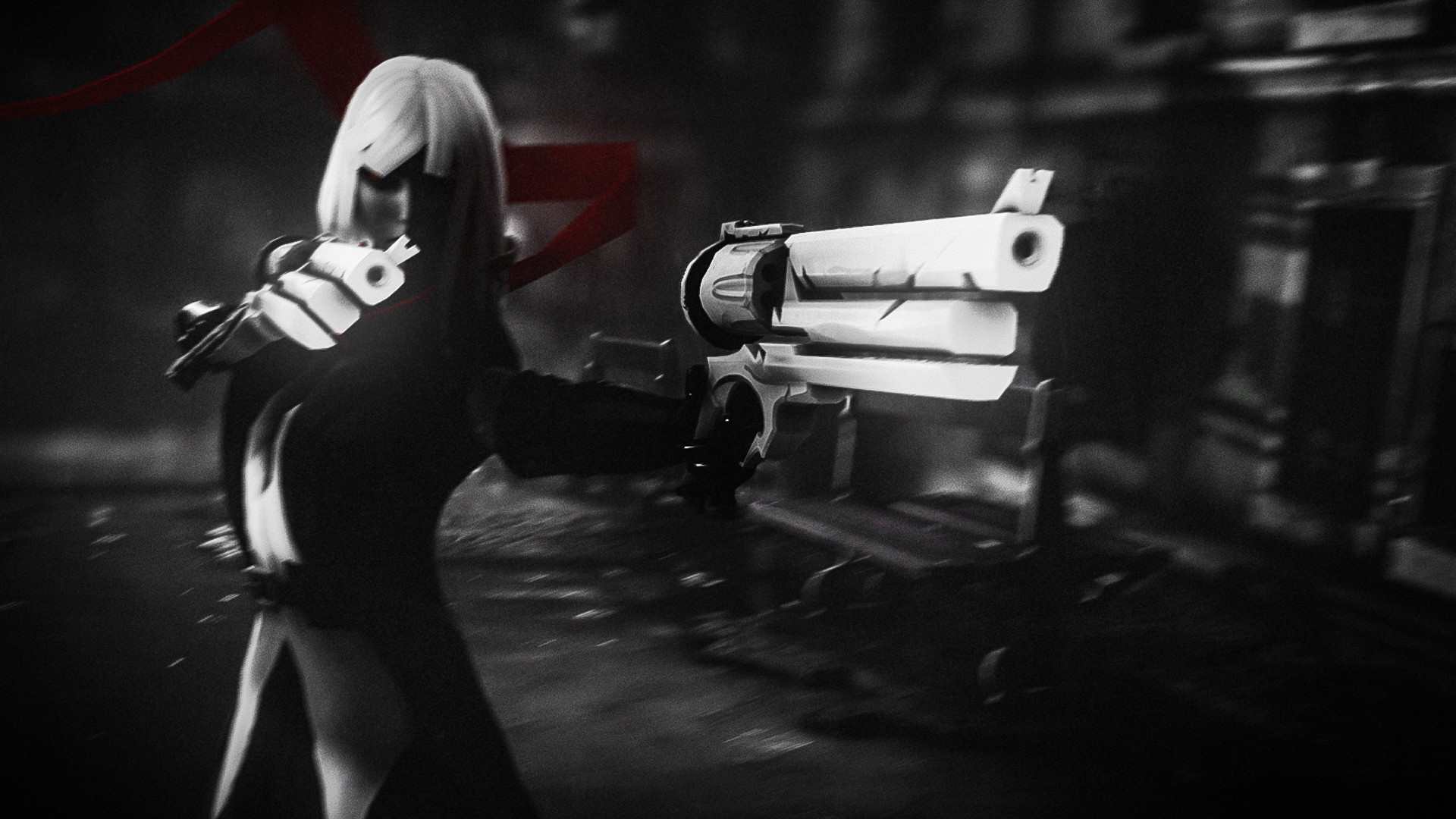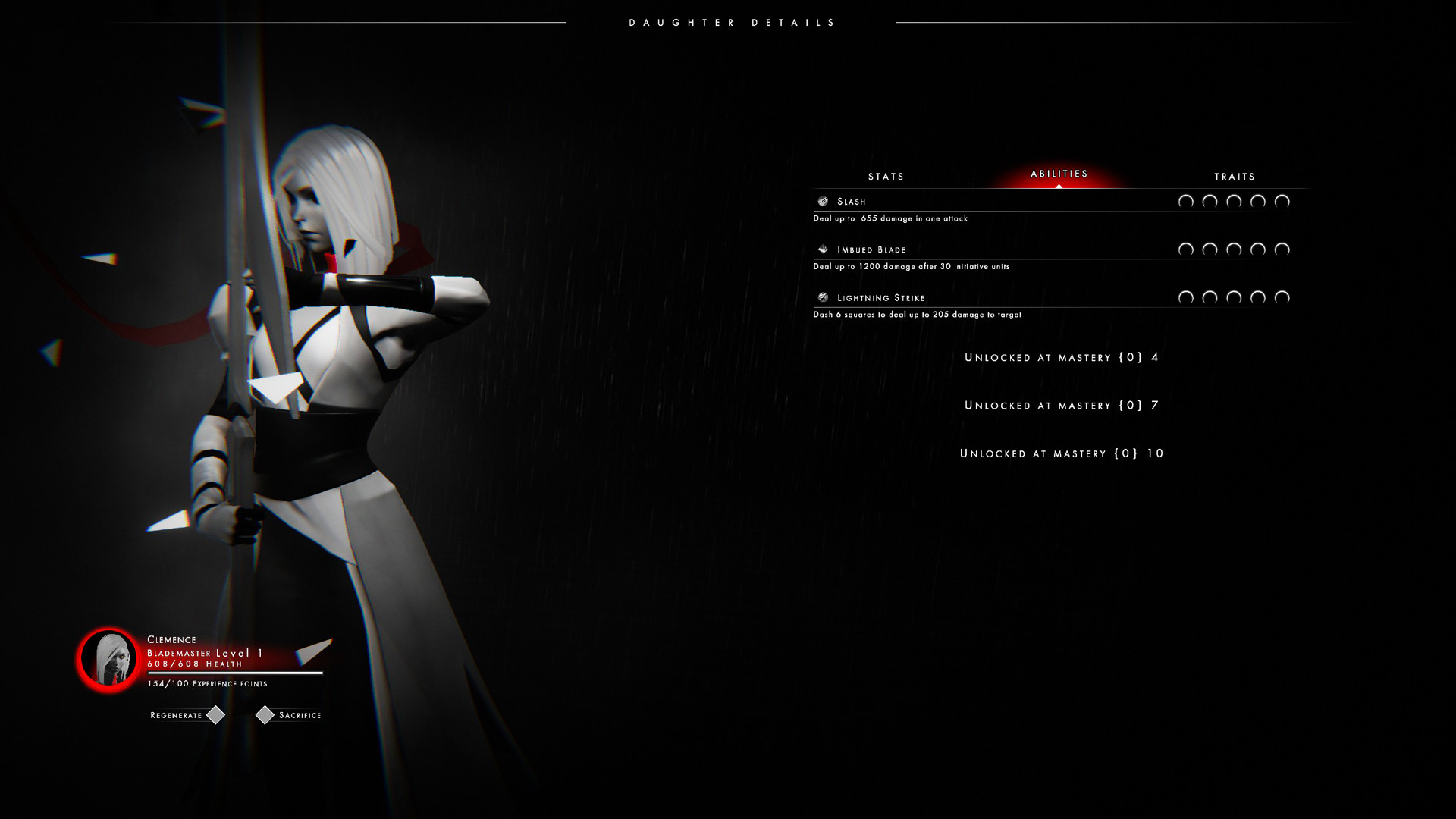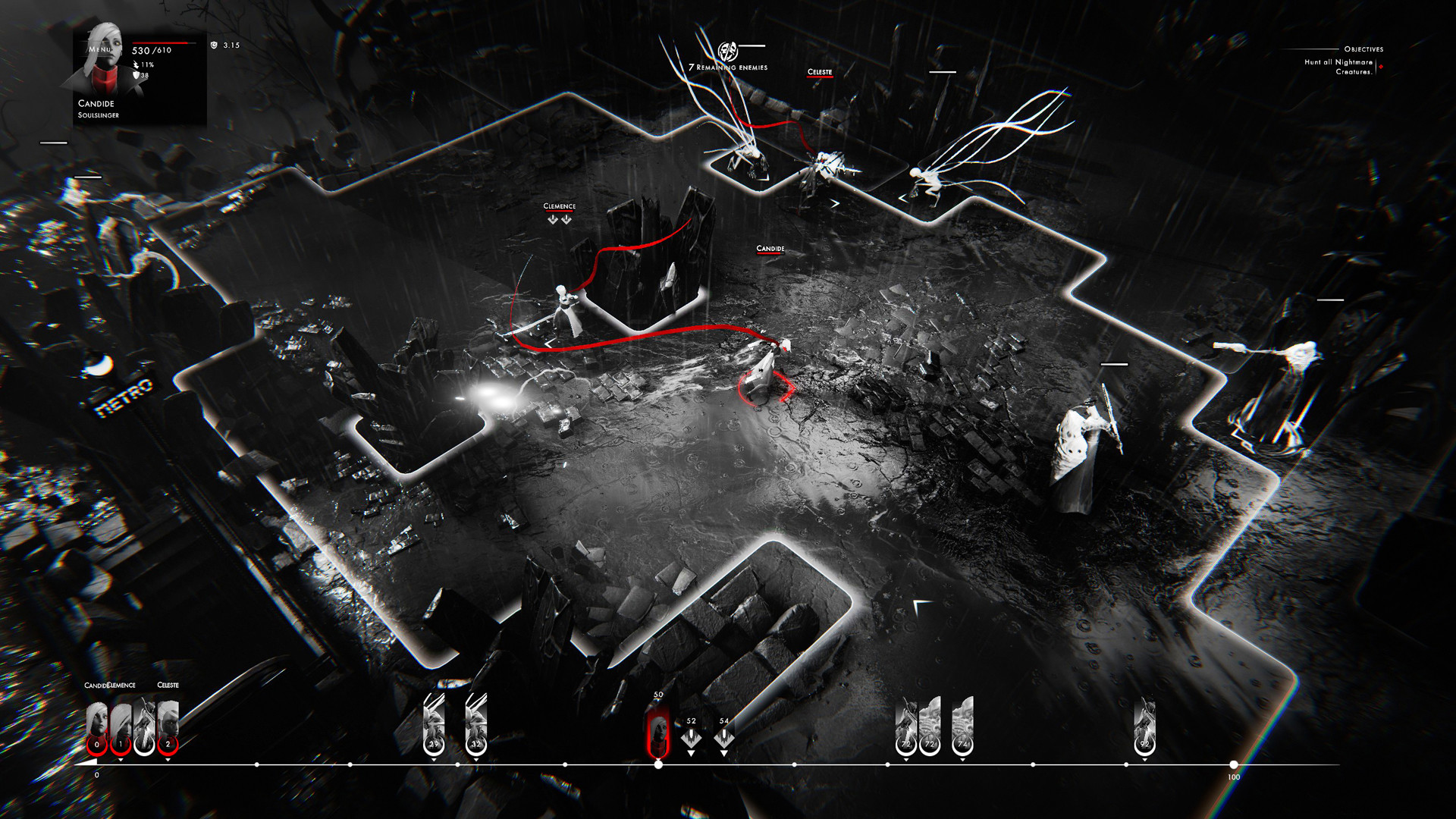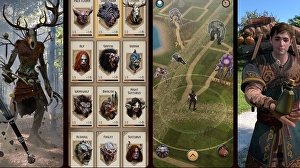
The turn-based tactics genre is one that inherently attracts audiences, but even among those, Lightbulb Crew’s Othercide immediately stands out from the crowd. At first glance, its striking monochromatic aesthetic with shocking flashes of red catches the eye, and when you look deeper, the promise of its fascinating setting and rich, deep mechanics and battles hint at exciting potential. And if the game’s reception from audiences and critics alike since its recent launch is anything to go by, it seems like that potential is something Othercide makes good on. Wanting to learn more about the game and what makes it tick, shortly before its launch, we sent across some of our most burning questions about it to its developers. You can read our interview with Larsson Anders (creative director and CEO of Lightbulb Crew) and Chaudret Alexandre (art director) below.
NOTE: This interview was conducted prior to the game’s launch.
"We wanted Othercide to stick out in the tactical genre and be immediately recognizable in a genre full of sci-fi, military, or heroic-fantasy universes and add a different flavor with a dark, grim, gruesome horror-themed vibe."
Othercide features a striking, beautiful visual aesthetic- can you talk us through the process of how you landed on this art style for the game
Chaudret Alexandre (Art Director): One funny thing about art direction, is how much it’s a balance between impulses and iterations over a long time: it is very much a consideration of choice and consequence. We wanted Othercide to stick out in the tactical genre and be immediately recognizable in a genre full of sci-fi, military, or heroic-fantasy universes and add a different flavor with a dark, grim, gruesome horror-themed vibe.
The idea of creating an “in-between two worlds” vibe, pinned on the edge of dreams and nightmares, drove the entire project into those twisted realms of symbolism and ethereal concepts. We tried to tie each element to the lore, as each single creature or environment is part of the multiple traumas of our main villain, the Child.
The strongest choice we made was to go all out on the black, white and red aesthetic, as we felt it depicted the “noir” and nightmarish feeling we wanted perfectly. Did you know that some people dream exclusively in black and white? This direction brought a lot of constraints, but pushed the art team to be creative in thinking of how to give the game a “soul”.
Othercide’s horror vibes certainly give it a very unique identity. Is that something that will play a big role in the game’s world and its story?
Alexandre: When Othercide deals with “horror”, don’t expect jump scares and flashlight gameplay! Our game deals with the dark psychological mood aspect of “horror”, trauma and metaphors. There is a certain beauty to be found in horror; there can’t be a beautiful light without an incredible shadow being cast.
The real horror comes when you ask yourself “why does this monster look like that, has this sound design, moves that way”, rather than being shocked by blood or a loud noise! The entire game and story were built with this mood in mind, and we think it’s created quite an interesting take on the tactical genre that usually keeps away from those themes.
Given Othercide’s fascinating premise and what seems like a very rich world, how much of an emphasis can players expect the game to put on worldbuilding and storytelling?
Alexandre: The story is in the image of the game and its art direction: it is ethereal, a symbolic struggle that goes beyond the battle between the Daughters and the Suffering Other. If it can seem quite cryptic at first, it slowly unveils as the players goes through the campaign. The story is presented in a minimalistic fashion through cut-scenes and moments in the game, in a way that allows players that only focus on the challenge of the game itself do so, and still get introduced to the universe hidden behind the dark curtain. For players that want to dig into the universe and the background of the main characters, there is an epic melancholic story to discover as the game goes on and you find memories to bury yourself in!
"When we set out to make Othercide, we noticed that some of the leaders in the genre maybe make great games, but would make pretty terrible action movies!"
Othercide’s Dynamic Timeline System is perhaps one of its most intriguing mechanics, one that looks like it will set it apart from other tactics games. What can you tell us about it, and the biggest ways it influences battles?
Larsson Anders (Creative Director / CEO): When we set out to make Othercide, we noticed that some of the leaders in the genre maybe make great games, but would make pretty terrible action movies! We wanted to recreate those epic situations where the bad guy gets interrupted in the last moment just as he is about to take out the hero. The Dynamic Timeline System is what makes this possible.
Many games have dealt with initiative, the order in which each character acts, in different ways including tabletop RPGs going back to DnD, many video games and now also board games. The Dynamic Timeline System is unique in the way it takes a central place in deciding your strategy and tactics.
Every move you make needs to be thought of in terms of the order that enemies and allies will act. Every move also comes with a choice, if you use too many action points, you will be set back further in the timeline and potentially act after enemies, exposing you to getting hit. To increase the reactivity, we introduced different types of actions: Direct actions happen immediately, while Delayed actions, and actions over time land after they are used. Finally, Reactions and Interruptions are prepared in advance and then respond to criteria, for example interrupting a melee attack, or reacting to an enemy taking damage.
Can you talk us through the different class options for the Daughters, and the biggest ways they differentiate from each other?
Alexandre: Each Daughter is a replica of an aspect of a great warrior, the Mother, that has been fighting the Others for centuries. Her memories were brought to life and created a legion of fierce warriors, ready to fight, fall and rise again to protect the Veil.
At the beginning of the game, you will have three classes to play with. The Blademaster, a lethal and powerful slayer with a giant sword, that can take down a creature in one blow but is very fragile when overexposed. She can be protected by the Shieldbearer, a tank type with a spear and a shield that can either save her sisters or delay the actions of the enemies. The third class is a mix of ranged attacks and support for the other Daughters: the Soulslinger uses a pair of giant pistols as well as esoteric psychic powers.
In addition to their natural skills, each Daughter is born with her own stats, and the more she gets into battle, the more she evolves to become a unique part of your army. Through “Traits” triggered by their actions on the battlefield, each Daughter receives passive bonuses that can really be big game changers for your team. You can also customize their skills by assigning “Memories” gems, and therefore prepare an ultimate team with its own advantages and flaws.
The concept of sacrificing one character to heal another is an intriguing one- what can you tell us about that?
Alexandre: Othercide is about hard choices: what will you sacrifice in order to survive? Who shall fall and who shall rise again? As you noticed, there is no healer class in the Daughter classes. The only way to heal a Daughter is to sacrifice another. But, in addition to the health regeneration, the sacrificed Daughter will give a part of her soul to the healed one, granting her with bonuses depending on class and level. It is a very powerful mechanism, and if it feels difficult at first to “sacrifice” your Daughters, it becomes a natural handover ritual from the older Daughters to the newest ones.
The entire game hinges upon around this idea of falling and rising again, and this theme is seen across many of the game’s aspects and your journey: defeat monstrous creatures to make your Daughters stronger, heal the ones that got wounded by sacrificing the others, grow the ultimate team and try to vanquish the bosses. Even death is not an end, and there are many ways to rise again and again, until final victory.
"Othercide is about hard choices: what will you sacrifice in order to survive? Who shall fall and who shall rise again?"
Othercide promises that players will not only be able to shape the abilities of the Daughters, but also their personalities. How will that materialize in terms of gameplay mechanics?
Anders: Well actually the player’s impact is indirect. The Daughters evolve with what happens to them in the game. If they are doing incredibly well their first mission, they can earn a positive trait that will make them better in the future. Failing in a mission and many other things can give traits that have negative aspects. Traits can really significantly change a Daughter and are reflections of what they have lived through.
Roughly how long will an average play through of Othercide be?
Anders: Othercide is different in that it is both the hardest game you have ever played and the easiest game you have ever played. The better you play the harder the challenge becomes, as a key part of becoming stronger is to then fail. This makes the expected playtime very different from person to person. We believe the game gives great value with its current pricing!
How is the game running on the original Xbox One and PS4, in terms of frame rate and resolution?
Anders: The game is running at a stable 30FPS at 1080P on both platforms.
What are the docked and undocked resolution and frame rate of the Switch version?
Anders: We are still working on the last modifications to the Switch. Our approach is to use flexible rendering to adapt the resolution of the 3D world to be able to keep the right trade-off between resolution and frame rate. The UI resolution is kept stable at 720p no matter what.
Given that next-gen consoles are right around the corner, have you given any thought to next-gen ports for the game?
Anders: We would love to make ports of Othercide to them. We will see when and if that happens.
"Othercide is different in that it is both the hardest game you have ever played and the easiest game you have ever played. The better you play the harder the challenge becomes, as a key part of becoming stronger is to then fail."
Since the reveal of the PS5 and Xbox Series X’s specs, a lot of comparisons have been made between the GPU speeds of the two consoles’ GPUs, with the PS5 at 10.28 TFLOPS and the Xbox Series X at 12 TFLOPS- but how much of an impact on development do you think that difference will have?
Anders: We have not gotten to this level of detail yet, but judging from the last generation of consoles it is likely that specific differences in architecture and tools between platforms will be more important than the pure HW specs. Also sure is that until developers have gotten used to the platforms idiosyncrasies their true capacity will not be reached.
The PS5 features an incredibly fast SSD with 5.5GB/s read bandwidth. This is faster than anything that is available out there. How can developers can take advantage of this and what will it result to, and how does this compare to Series X’s 2.4GB/s read bandwidth?
Anders: Faster load times are really significant for the player experience. This might be the most significant update that can impact almost all games on the new consoles. The specific hardware specs are likely to not be the main differentiator for most games but rather the ability to handle it through tools etc. We will have to wait to see the effects.
There is a difference in the Zen 2 CPUs of both consoles. The Xbox series X features 8x Zen 2 Cores at 3.8GHz, whereas the PS5 features 8x Zen 2 Cores at 3.5GHz. Your thoughts on this difference?
Anders: I would think that especially here any differences in theoretical performance will be overtaken by the idiosyncrasies of each platform’s architecture and tools.
So, there is a power difference between the two new consoles, there is no doubt about that. But do you think that power advantage of the Xbox Series X will matter given Microsoft’s cross gen policy?
Anders: Each platform comes with the first party’s own restrictions and regulations. What is sure is that for smaller developers it will be hard to make games that manage to take full use of the graphics opportunities in the new consoles while also releasing games on PS4/X1. Every developer will have to think hard where their efforts can pay off, given the type of game they are making.








